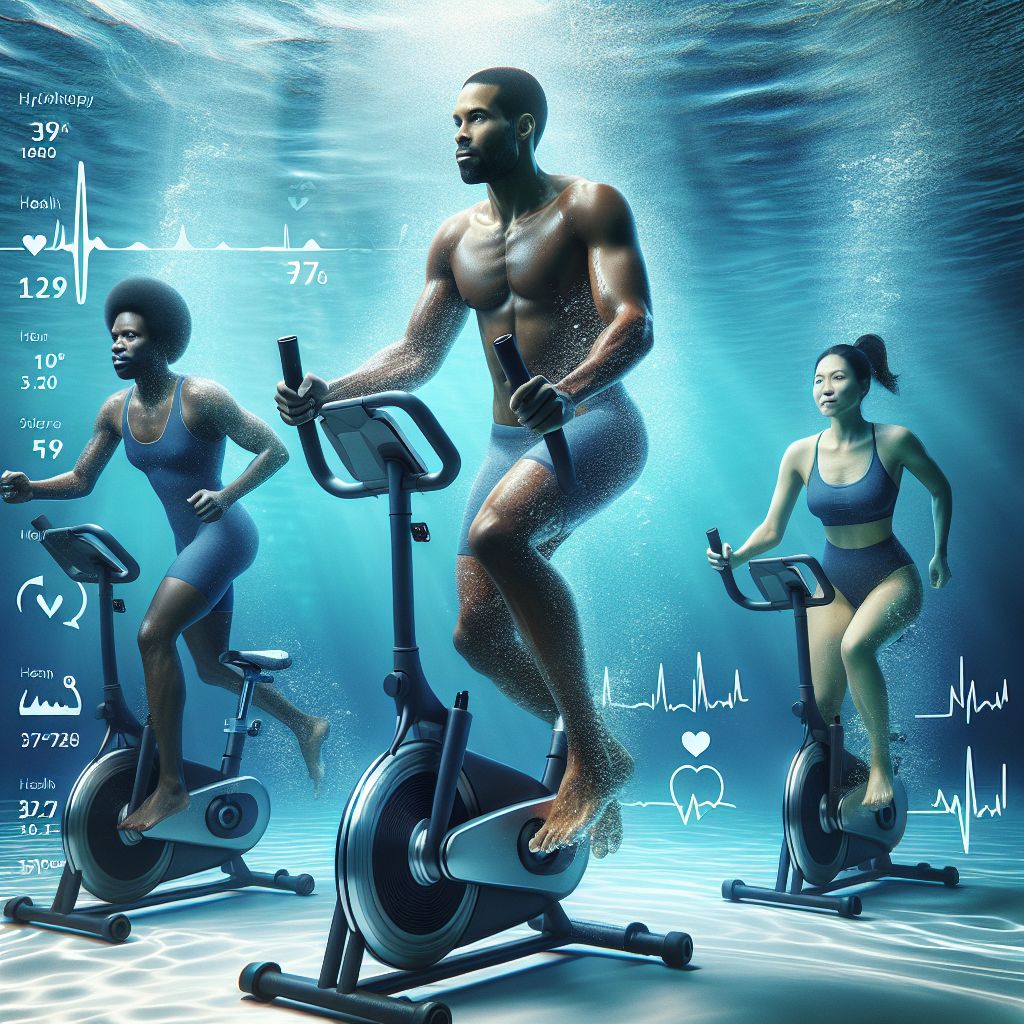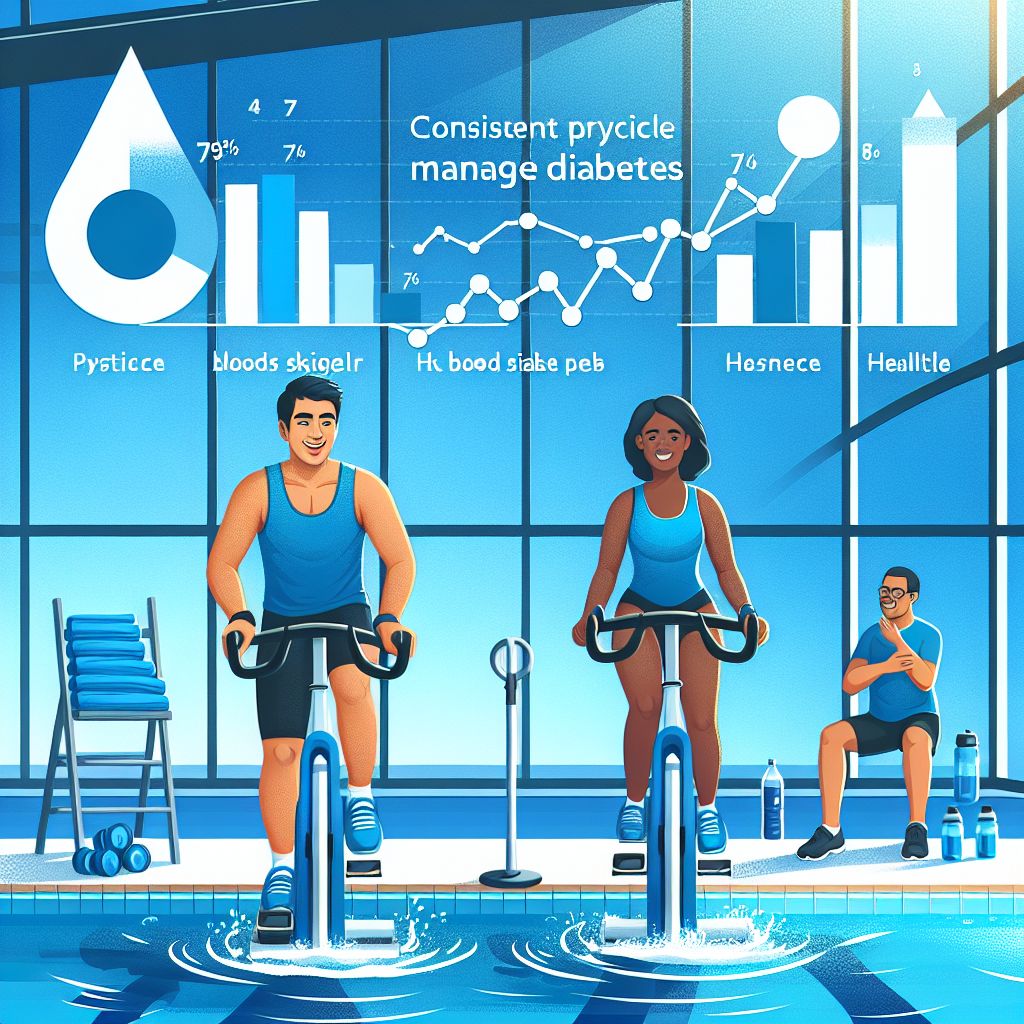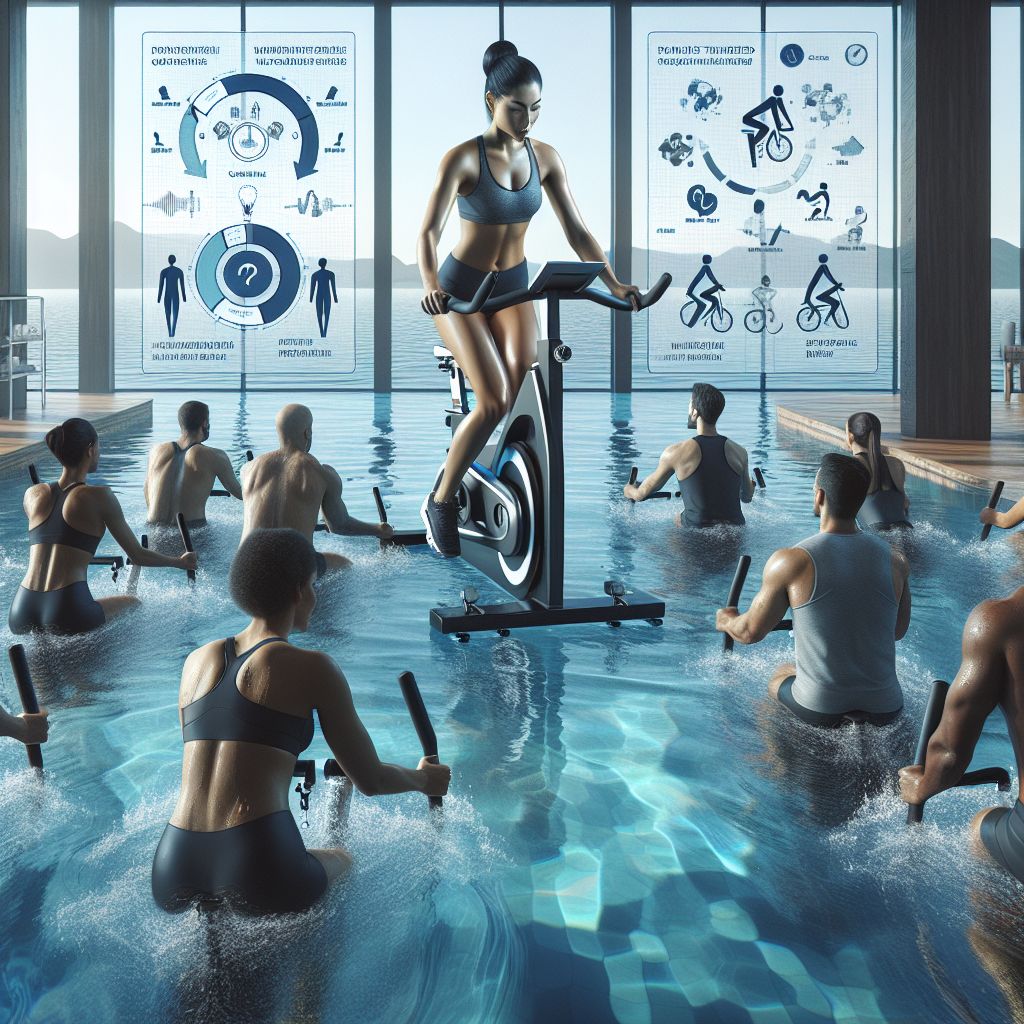
Key Takeaways
-
AquaBiking is a form of hydrotherapy that can help manage blood sugar levels in diabetics.
-
This low-impact exercise is ideal for joint preservation and improving cardiovascular health.
-
Regular AquaBike sessions can enhance energy, aid in weight management, and improve overall diabetic health.
-
Getting started with AquaBiking is simple and requires no special gear, making it accessible for many people.
-
Consistent practice and integrating AquaBiking into your routine can yield significant health benefits for those managing diabetes.
Dive into Diabetic Wellness with AquaBiking
When it comes to managing diabetes, finding the right exercise routine can be as crucial as your diet. Let me introduce you to AquaBiking – a refreshing approach to diabetic fitness that combines the benefits of water resistance with the ease of cycling. Imagine the joy of pedaling through water; it’s fun, it’s effective, and most importantly, it’s a game-changer for your health.
The Ripple Effect of AquaBiking on Blood Sugar Levels
One of the biggest challenges for diabetics is maintaining steady blood sugar levels. Here’s where AquaBiking shines. The resistance of the water means your body works harder, but without the strain on your joints. This means you can have a vigorous workout that directly impacts your blood sugar management, without the risks associated with high-impact exercises.
Hydrotherapy: A Wave of Relief for Diabetes Management
Hydrotherapy has long been recognized for its therapeutic benefits. For those with diabetes, it’s a soothing yet powerful ally. The buoyancy of water reduces stress on the body, allowing for a more intense workout with a lower risk of injury. Plus, the cooling effect of water makes exercising a more comfortable and enjoyable experience, especially if you’re prone to overheating.
Understanding Diabetic Hydrotherapy
Before diving deeper into AquaBiking, let’s break down the concept of diabetic hydrotherapy. It’s a form of exercise that takes place in water, utilizing its properties to aid in the management of diabetes. The water provides resistance, which helps build muscle strength, while the hydrostatic pressure aids in reducing swelling and improving circulation – both are essential for diabetic health.
The Science of Water Workouts for Blood Sugar Control
Several studies have shown that water workouts can lower blood sugar levels and improve insulin sensitivity. This is because exercising muscles consume glucose for energy, which helps to lower blood sugar levels. The resistance of the water amplifies this effect, as your body has to work harder than it would on land.
Aqua Therapy Techniques for Diabetics
Now, let’s focus on AquaBiking. You’ll be seated on a stationary bike that’s submerged in water, usually up to waist height. As you pedal, the water adds resistance, which increases the intensity of the workout without adding pressure on your joints. This makes it an excellent option for those with diabetic neuropathy or other complications that make traditional exercise difficult.
Transitioning from understanding the science behind AquaBiking and hydrotherapy, let’s delve into the tangible benefits it brings to individuals managing diabetes, particularly in terms of joint health and cardiovascular improvement.
Low-Impact, High-Efficiency: AquaBiking for Joint Preservation
Joint preservation is a crucial consideration for anyone, but it’s particularly important for those with diabetes, who may face joint-related issues due to inflammation or neuropathy. AquaBiking stands out because it’s a low-impact activity. The water supports your body weight, easing the load on your joints while you get your heart rate up and work your muscles. This means you can pedal your way to better health without the worry of over-stressing your knees, hips, or ankles.
Cardiovascular Perks of Pedaling in the Pool
Heart health cannot be overlooked in diabetes management. AquaBiking is not just about joint protection; it’s also a potent cardiovascular workout. The consistent movement and resistance in the water improve heart function and circulation, which is vital for everyone, but especially for those with diabetes, as they are at an increased risk for heart disease. By incorporating AquaBiking into your routine, you’re not just balancing your blood sugar levels – you’re giving your heart the attention it deserves.
AquaBiking: A Real-Life Diabetes Ally

It’s one thing to talk about the potential benefits of an exercise regime, but it’s another to see its impact in real life. Many individuals with diabetes have turned to AquaBiking and witnessed remarkable improvements in their health. Regular sessions can help in maintaining a healthier weight, which is a significant factor in diabetes control. The activity is also known to boost mood and mental health, providing a holistic approach to managing the condition.
-
Improved glycemic control
-
Enhanced weight management
-
Increased muscle strength and flexibility
-
Boosted mental well-being
-
Reduced risk of cardiovascular disease
These benefits combine to make AquaBiking more than just a workout – it’s a powerful ally in the journey towards a healthier diabetic lifestyle.
Personal Stories: Transformations Through AquaBike
Take John, for example, a 52-year-old with type 2 diabetes who struggled with fluctuating blood sugar levels and joint pain that made traditional exercise challenging. After incorporating AquaBiking into his weekly routine, John noticed not only a significant stabilization in his blood sugar levels but also a reduction in his joint discomfort. His energy levels soared, and he even managed to reduce his diabetes medication with his doctor’s guidance. John’s story is a testament to the transformative power of AquaBiking for individuals with diabetes.
Fueling Fitness: How AquaBiking Enhances Energy and Strength
Aside from the cardiovascular and joint benefits, AquaBiking serves as a powerful tool for enhancing energy and building strength. The resistance of water provides a comprehensive workout that targets multiple muscle groups simultaneously. This means that as you pedal, you’re not only burning calories and managing your blood sugar levels, but you’re also strengthening your legs, core, and even your upper body as you stabilize yourself on the bike.
-
Engage and strengthen multiple muscle groups at once.
-
Boost stamina and endurance.
-
Improve balance and core stability.
By building muscle, you’re also increasing your resting metabolic rate, which helps in burning more calories throughout the day, even when you’re not exercising. This can be particularly beneficial for weight management, a critical aspect of diabetes control.
The Nitty-Gritty of AquaBike Workouts

Now that you’re familiar with the benefits, let’s talk about how to get started with AquaBiking. First off, you don’t need any special equipment. Most facilities that offer AquaBiking have the bikes already submerged in the pool. You’ll just need a swimsuit and the willingness to try something new.
Getting Started: The First Pedal Stroke
Your first AquaBike session will likely be an exciting new experience. You’ll get on the bike, and the instructor will help you adjust the seat and handlebars to ensure you’re comfortable. They’ll guide you through a warm-up to get your muscles ready for the workout. Don’t worry if you’re not a strong swimmer – your feet will touch the pool floor, and your head will be well above water at all times.
As you start pedaling, you’ll feel the resistance of the water, which might be a bit surprising at first. But soon, you’ll get into the rhythm and start enjoying the unique sensation of cycling underwater. Remember, the key is to go at your own pace. There’s no rush, and you can increase the intensity as you become more comfortable with the exercise.
Making Waves: Intensity Levels and Duration Tips
One of the great things about AquaBiking is that you can adjust the intensity to match your fitness level. Beginners might start with a 15 to 20-minute session at a moderate pace, while more experienced individuals could aim for 30 to 45 minutes with increased resistance. Here are a few tips to help you make the most of your AquaBike workouts:
-
Start slow and gradually increase the duration and intensity of your workouts.
-
Focus on maintaining a steady pace that keeps your heart rate up but still allows you to breathe comfortably.
-
Try different resistance levels to challenge your muscles and prevent plateaus.
Consistency is key, so aim for at least two to three sessions per week to see the best results. And always listen to your body – if you need a break, take it. With time, you’ll find that AquaBiking is not just beneficial for your diabetes management, but it’s also an enjoyable part of your weekly routine.
FAQs
For more information on how hydrotherapy can benefit individuals with diabetes, explore our detailed article on diabetic hydrotherapy benefits.
1. Who Can Participate in AquaBike Therapy?
AquaBike therapy is for everyone looking to manage their diabetes with a smile. Whether you’re a seasoned athlete or haven’t exercised in years, AquaBiking is adaptable to all fitness levels. It’s especially beneficial for those who may have mobility issues, joint pain, or are overweight, as the water’s buoyancy significantly reduces the impact on the body. Even if you’re new to exercise, AquaBiking can be a gentle yet effective way to get moving.
2. How Often Should I AquaBike for Optimal Benefits?
To reap the full benefits of AquaBiking, especially for individuals managing conditions such as diabetes, consistency is key. While the optimal frequency can vary based on individual health goals and physical condition, incorporating this exercise into your routine can be a game-changer. For more detailed information on the benefits of hydrotherapy for diabetes, consider exploring diabetic hydrotherapy education workshops.
To really tap into the benefits of AquaBiking, consistency is crucial. I recommend starting with two to three sessions a week. Each session should be about 30 minutes to an hour, depending on your comfort and fitness level. As your body adapts, you can increase the frequency and intensity. The key is to build a routine that fits into your lifestyle and that you can stick to in the long term.
-
Start with 2-3 sessions per week.
-
Each session should last 30-60 minutes.
-
Gradually increase frequency and intensity based on comfort and fitness.
3. Do I Need Special Gear for AquaBike Sessions?
While you don’t need a lot of equipment to get started with AquaBike sessions, ensuring you have the right gear can enhance your experience. For more information on what you might need, check out HYDRORIDER’s essential aquabike gear.
The beauty of AquaBiking is its simplicity. All you really need is a swimsuit and a towel. Some people prefer to wear water shoes for added grip on the pool floor, but they’re not necessary. The AquaBike and the pool provide everything else you need for an effective workout. Just show up ready to pedal, and the rest is taken care of.
4. Can AquaBiking Replace My Current Diabetes Exercise Regimen?
AquaBiking is a fantastic addition to any diabetes exercise regimen, but whether it can replace your current routine depends on several factors. If you’re looking for a low-impact option that’s easy on the joints and fun to do, AquaBiking might just be the perfect fit. However, it’s important to maintain a balanced exercise program that includes flexibility, strength training, and aerobic activities. Consult with your healthcare provider to determine the best exercise plan for your needs.
5.Where Can I Find an AquaBike Facility Near Me?
Finding an AquaBike facility is easier than you might think. Many local gyms, community centers, and specialized fitness studios now offer AquaBike classes. A quick online search or a phone call to nearby pools can point you in the right direction. Some places even offer a free trial class, so you can dip your toes in the water before committing to a full session.
In conclusion, AquaBiking stands out as a remarkable form of diabetic hydrotherapy that strikes a balance between fun and functionality. By pedaling in the pool, you’re not just working towards managing your blood sugar levels; you’re also taking a step towards a healthier heart, stronger muscles, and a happier life. It’s an all-around win for anyone looking to improve their diabetic health. So grab your swimsuit, find your nearest AquaBike class, and get ready to make some waves in your diabetes management journey.



Leave a Reply